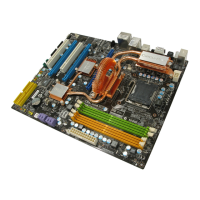3-21
BIOS Setup
1.If you do not have any EMI problem, leave the setting at [Disabled] for
optimal system stability and performance. But if you are plagued by EMI,
select the value of Spread Spectrum for EMI reduction.
2.The greater the Spread Spectrum value is, the greater the EMI is reduced,
and the system will become less stable. For the most suitable Spread
Spectrum value, please consult your local EMI regulation.
3.Remember to disable Spread Spectrum if you are overclocking because
even a slight jitter can introduce a temporary boost in clock speed which
may just cause your overclocked processor to lock up.
Important
1T/2T Memory Timing
This item controls the SDRAM command rate. Select [1T] makes SDRAM signal
controller to run at 1T (T=clock cycles) rate. Selecting [2T] makes SDRAM signal
controller run at 2T rate.
Adjust PCI-E Frequency (MHz)
This field allows you to select the PCI-E frequency (in MHz).
CPU Voltage (V)
This item allows you to increase the CPU voltage.
Memory Voltage (V)
Adjusting the memory voltage can increase the memory speed.
VTT FSB Voltage (V)
This item allows you to set the FSB VTT voltage.
NB Voltage (V)
Adjust the North Bridge chipset voltage.
SB Voltage (V)
Adjust the Sourth Bridge voltage.
Spread Spectrum
When the motherboard’s clock generator pulses, the extreme values (spikes) of the
pulses create EMI (Electromagnetic Interference). The Spread Spectrum function
reduces the EMI generated by modulating the pulses so that the spikes of the pulses
are reduced to flatter curves. If you do not have any EMI problem, leave the setting at
Disabled for optimal system stability and performance. But if you are plagued by EMI,
set to Enabled for EMI reduction. Remember to disable Spread Spectrum if you are
overclocking because even a slight jitter can introduce a temporary boost in clock
speed which may just cause your overclocked processor to lock up.

